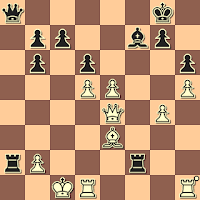With due respect to Dennis, at the club level the entire Jerome Gambit can be considered a "trap" - especially if we consider psychological aspects. Black must pay attention, even as he treasures his advantages, or they will evaporate.
Wall, Bill - Guest5436627
PlayChess.com, 2018
1.e4 e5 2.Nf3 Nc6 3.Bc4 Bc5 4.Bxf7+
4...Kxf7 5.Nxe5+ Nxe5 6.d4 Bxd4 7.Qxd4 d6
8.O-O Be6
Or 8...Nf6. See "Jerome Gambit: Tactic Fatigue" for a discussion.
9.f4 Nc6 10.Qa4 Nf6
Black is doing well. He has attended to his development, and can protect his King in short order.
White, on the other hand, has to continue to find ways to sow disorder.
11.f5 Bd7 12.Qb3+ Ke7
I am not sure about this. Perhaps the King should go to f8.
13.Nc3 Re8 14.Nd5+ Nxd5
Of course, Black should have moved his King away, instead, with 14...Kf8, but it's no big deal, right?
15.exd5 Ne5
Suddenly Black's King feels a draft along the e-file, and so he blocks it off with his Knight. Sadly, to keep the position about level (White would have an edge) he needed to give up his extra piece with 15...Nd4 16.Qe3+ Kf8 17.Qxd4).
Now, danger comes from another direction.
16.Bg5+ Black resigned







































